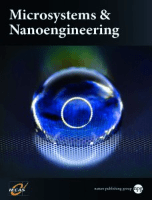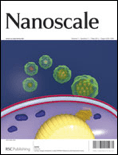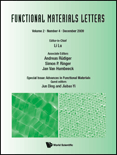
Microsystems & Nanoengineering
Scope & Guideline
Exploring Interdisciplinary Connections in Nanoengineering
Introduction
Aims and Scopes
- Micro- and Nanoscale Fabrication Techniques:
Research in this area involves innovative methods for the fabrication of micro- and nanostructures, utilizing techniques such as 3D printing, laser engraving, and advanced lithography. These methods are crucial for creating devices with enhanced functionality and precision. - Biomedical Applications:
The journal publishes studies on microsystems and nanotechnology applications in healthcare, including drug delivery systems, biosensors, and implantable devices. This focus highlights the role of technology in advancing medical diagnostics and therapies. - Sensors and Sensing Technologies:
A significant portion of the research is dedicated to the development of novel sensors, including those for environmental monitoring and health diagnostics. These studies often explore sensitivity, specificity, and the integration of sensors into wearable devices. - Energy Harvesting and Management:
Research on energy harvesting technologies, such as piezoelectric and triboelectric systems, is prevalent. This includes studies on the integration of energy management systems within microscale devices to enable sustainable operation. - Microfluidics and Lab-on-a-Chip Systems:
The journal features research on microfluidic devices that facilitate chemical and biological analyses at the microscale. This includes innovations in sample handling, reaction control, and real-time monitoring. - Soft Robotics and Flexible Electronics:
Research in this area emphasizes the design and application of soft materials for robotics and flexible electronics, focusing on their adaptability and integration into various environments, particularly in health monitoring and assistive technologies.
Trending and Emerging
- Wearable and Implantable Devices:
Recent publications have increasingly focused on the development of wearable and implantable devices for health monitoring and disease management. This trend highlights the growing interest in personal health technology and the integration of microsystems into everyday life. - Advanced Biosensors:
There is a marked increase in research dedicated to biosensors capable of real-time monitoring of biological markers. This includes the use of microfluidics and nanomaterials to enhance sensitivity and specificity for medical diagnostics. - Sustainable and Eco-friendly Technologies:
Emerging research themes emphasize sustainability, including the development of eco-friendly materials and energy-efficient devices. This trend aligns with global efforts to promote green technologies and reduce environmental impact. - Smart and Adaptive Systems:
The journal is seeing a rise in studies that incorporate artificial intelligence and machine learning into microdevices, enabling adaptive functionalities and improved performance in sensing and actuation. - Integration of Nanomaterials:
Research focusing on the use of nanomaterials, such as graphene and MXenes, in enhancing device performance is increasingly prevalent. These materials offer unique properties that can significantly improve the functionality of microdevices. - Micro-robotics and Autonomous Systems:
There is a growing interest in micro-robotics, particularly in applications for medical procedures and environmental monitoring. The development of autonomous systems that can operate at the microscale is a notable trend in recent publications.
Declining or Waning
- Traditional MEMS Technologies:
Research related to conventional MEMS (Micro-Electro-Mechanical Systems) technologies has seen a reduction in focus as newer, more versatile technologies emerge. This includes MEMS devices that do not incorporate advanced materials or novel configurations. - Conventional Materials for Microdevices:
There has been a noticeable decline in studies focusing on traditional materials such as silicon and glass for microdevice fabrication. Research is increasingly shifting towards novel materials like MXenes and 2D materials which offer superior properties. - Static Sensors:
The interest in static sensor designs, which do not incorporate adaptive or smart features, has waned. The trend is moving towards dynamic sensing systems that provide real-time data and adaptability in various environments. - Basic Theoretical Studies:
There has been a decline in purely theoretical research without experimental validation. The journal now favors studies that combine theoretical insights with practical applications and empirical results. - Low-tech Applications:
Research focusing on low-tech or non-innovative applications of microsystems has diminished. The journal is increasingly prioritizing high-impact studies that demonstrate advanced technology applications.
Similar Journals

MICROSYSTEM TECHNOLOGIES-MICRO-AND NANOSYSTEMS-INFORMATION STORAGE AND PROCESSING SYSTEMS
Driving knowledge in cutting-edge information processing systems.MICROSYSTEM TECHNOLOGIES-MICRO-AND NANOSYSTEMS-INFORMATION STORAGE AND PROCESSING SYSTEMS is an esteemed scholarly journal published by SPRINGER HEIDELBERG, bringing together cutting-edge research in the fields of microsystems and nanosystems, with a specific focus on information storage and processing technologies. With its origins tracing back to 1994, this journal has established a solid reputation within the academic community and currently ranks in Q3 across key disciplines, including Condensed Matter Physics and Electrical and Electronic Engineering, as assessed by the 2023 category quartiles. The journal is notable for its contribution to advancing knowledge in Nanoscience and Materials Science, particularly in the domains of electronic, optical, and magnetic materials. As a pivotal resource for researchers, professionals, and students alike, it offers insights into innovative methodologies, applications, and breakthroughs in microsystems technologies that are shaping the future of electronics and computing. While currently not an open-access journal, it maintains a commitment to disseminating significant findings in the rapidly evolving landscape of information processing systems, fostering collaboration and knowledge exchange within the scientific community.

SmartMat
Exploring New Frontiers in Material Mechanics.SmartMat is a cutting-edge, peer-reviewed academic journal published by WILEY, dedicated to the fields of Chemistry, Materials Science, and Mechanics of Materials. Launched in 2020, this Open Access journal aims to disseminate high-quality research and innovative findings that bridge these interdisciplinary areas. With an impressive impact factor reflecting its strong scholarly influence, SmartMat currently holds the prestigious Q1 category ranking in key domains such as Chemistry (miscellaneous), Materials Science (miscellaneous), and Mechanics of Materials, underscoring its relevance and importance in advancing material research. The journal is ranked among the top in its fields on Scopus, with 98th and 97th percentiles for Engineering and Chemistry rankings, respectively. Researchers, professionals, and students looking for a platform to share advancements in smart materials and their applications are encouraged to explore the wide-ranging access options available, enhancing visibility and engagement with global scientific communities.

Discover Nano
Empowering Researchers to Transform NanotechnologyDiscover Nano is a pioneering journal published by SPRINGER, dedicated to the rapidly evolving field of nanoscience and nanotechnology. Established in 2023, this innovative platform provides an open-access forum for researchers, professionals, and students to share and disseminate cutting-edge findings in materials science and condensed matter physics. With its commitment to accessibility, Discover Nano encourages a broad spectrum of contributions, aiming to foster collaboration and stimulate discussion in this dynamic area of study. As a new entry into the academic community, the journal holds great potential for growth, aspiring to increase its visibility and impact in the materials science arena, where it currently ranks in the bottom quartile for both materials science and physics categories. Based in Germany and reaching a global audience, Discover Nano represents a significant opportunity for those looking to shape the future of nanotechnology through impactful research and interdisciplinary dialogue.

Nanotechnology and Precision Engineering
Catalyzing innovation through open access scholarship.Nanotechnology and Precision Engineering is a leading open access journal published by AIP Publishing, dedicated to advancing the fields of nanotechnology and precision engineering. Established in 2006, the journal has become a vital resource for researchers, professionals, and students, reflecting the latest advancements in Electrical and Electronic Engineering, Industrial and Manufacturing Engineering, Instrumentation, Mechanical Engineering, and Nanoscience. With an impressive variety of quartile rankings in Scopus—notably Q1 in several key engineering domains—the journal provides a robust platform for disseminating groundbreaking research. Noteworthy aspects include its open access format introduced in 2018, ensuring that high-quality research is freely accessible to a global audience. By maintaining a commitment to excellence and collaboration, Nanotechnology and Precision Engineering plays a crucial role in shaping the future of technology and innovation.

Nanoscale
Connecting Global Minds in Nanoscience.Nanoscale is a premier academic journal published by the Royal Society of Chemistry, dedicated to advancing the field of nanoscience and nanotechnology. With both its ISSN (2040-3364) and E-ISSN (2040-3372) ensuring wide accessibility, the journal is renowned for its high-impact research contributions, reflected in its impressive 2023 Impact Factor and prestigious Q1 ranking in both Materials Science (Miscellaneous) and Nanoscience and Nanotechnology categories. Since its inception in 2009, Nanoscale has fostered a collaborative platform where leading researchers from around the globe share their innovative findings across a multitude of topics spanning from material synthesis to applications in nanotechnology. The journal not only serves as a valuable resource for professionals, researchers, and students but also actively engages the academic community in discussing emerging trends, thus shaping the future of nanoscience. Situated in the heart of the UK at Thomas Graham House, Science Park, Milton Rd, Cambridge CB4 0WF, Nanoscale remains a key publication for those looking to keep abreast of the latest breakthroughs in an ever-evolving field.

Functional Materials Letters
Driving innovation in materials science and engineering.Functional Materials Letters, published by World Scientific Publishing Co. Pte Ltd, is an esteemed academic journal dedicated to disseminating cutting-edge research in the field of materials science. Since its inception in 2008, the journal has provided a vital platform for researchers, professionals, and students to share their discoveries pertaining to functional materials, which are integral for diverse applications ranging from electronics to advanced manufacturing. With an ISSN of 1793-6047 and an E-ISSN of 1793-7213, the journal operates out of Singapore and maintains a notable presence in the global academic community, currently ranked in the Q3 quartile for materials science. Although it does not offer open access, the journal ensures that its publications are rigorously peer-reviewed, contributing significantly to the advancement of knowledge in this rapidly evolving field. Researchers aiming to stay at the forefront of materials science will find Functional Materials Letters an indispensable resource that highlights innovative findings and fosters collaboration among scholars.

Biomedical Engineering Letters
Connecting scholars to elevate biomedical engineering.Biomedical Engineering Letters, published by SpringerNature, is a prominent journal in the field of Biomedical Engineering. With a robust ISSN of 2093-9868 and E-ISSN of 2093-985X, this esteemed journal has established itself as a vital resource for researchers and professionals seeking to advance their knowledge and share groundbreaking findings. Recognized for its quality, Biomedical Engineering Letters holds a distinguished ranking in Scopus, positioned at #94/303 (69th percentile) in the Biomedical Engineering category. The journal covers a diverse scope within biomedical engineering, providing an important platform for innovative research from 2011 to 2024 and facilitating the exchange of ideas among scholars. Although it operates under a subscription model, the journal's commitment to enhancing the field makes it an indispensable reference for those engaged in cutting-edge biomedical research in Germany and globally.

ELECTRONICS LETTERS
Transforming Research into Real-World Applications.ELECTRONICS LETTERS, published by WILEY, is a leading peer-reviewed journal dedicated to the field of Electrical and Electronic Engineering. With a rich history dating back to 1965, this journal serves as a prominent platform for disseminating novel research and innovations in electronics, covering topics such as circuit design, telecommunications, and signal processing. In 2021, the journal transitioned to an Open Access format, ensuring that cutting-edge research is freely accessible to a global audience, thereby enhancing its impact and outreach. The journal currently holds a Q3 quartile ranking in its category, reflecting its solid position among its peers, and ranks #451 out of 797 in Scopus for Electrical and Electronic Engineering, placing it within the 43rd percentile. ELECTRONICS LETTERS is essential for researchers, professionals, and students looking to stay abreast of the latest developments and contribute to advancements in the field, fostering collaboration and knowledge sharing in a rapidly evolving landscape.

Annual Review of Biomedical Engineering
Synthesizing Knowledge to Propel Biomedical Engineering ForwardAnnual Review of Biomedical Engineering, published by Annual Reviews, stands as a leading academic journal dedicated to the rapidly evolving field of biomedical engineering. With an impressive impact factor that reflects its high citation rates and rigorous peer-review process, this journal offers critical insights by synthesizing cutting-edge advancements and applications in both biomedical engineering and miscellaneous medicine. The journal, which is available in both print (ISSN: 1523-9829) and electronic formats (E-ISSN: 1545-4274), serves as an essential resource for researchers, professionals, and students aiming to stay abreast of significant developments and emerging trends. As of 2023, it is recognized in the top tier (Q1) for both Biomedical Engineering and Medicine, showcasing its esteemed position within the academic community, reflected in its high Scopus rankings. Spanning from 1999 to 2024, the Annual Review of Biomedical Engineering continues to catalyze interdisciplinary collaboration and innovation at the intersection of engineering and healthcare.

ACS Nanoscience Au
Advancing the Frontiers of NanoscienceACS Nanoscience Au, published by the American Chemical Society, is a leading open-access journal dedicated to the rapidly evolving field of nanoscience. Since its inception in 2021, this journal has established itself within the top quartiles of academic publishing, ranking Q1 in both Chemistry and Materials Science for 2023. With a commitment to disseminating high-quality research, it provides a platform for innovative findings in nanomaterials, nanotechnology applications, and associated interdisciplinary studies. The journal is based in the United States and embraces an open-access model, ensuring that research is freely accessible to a global audience. This initiative not only enhances the visibility of authors' work but also facilitates collaboration across scientific domains. As a vital resource for researchers, professionals, and students alike, ACS Nanoscience Au plays a crucial role in advancing knowledge in the nanoscience community.